Applied Corporate Strategy Assignment : Zara
VerifiedAdded on 2021/02/19
|13
|4362
|68
AI Summary
Contribute Materials
Your contribution can guide someone’s learning journey. Share your
documents today.
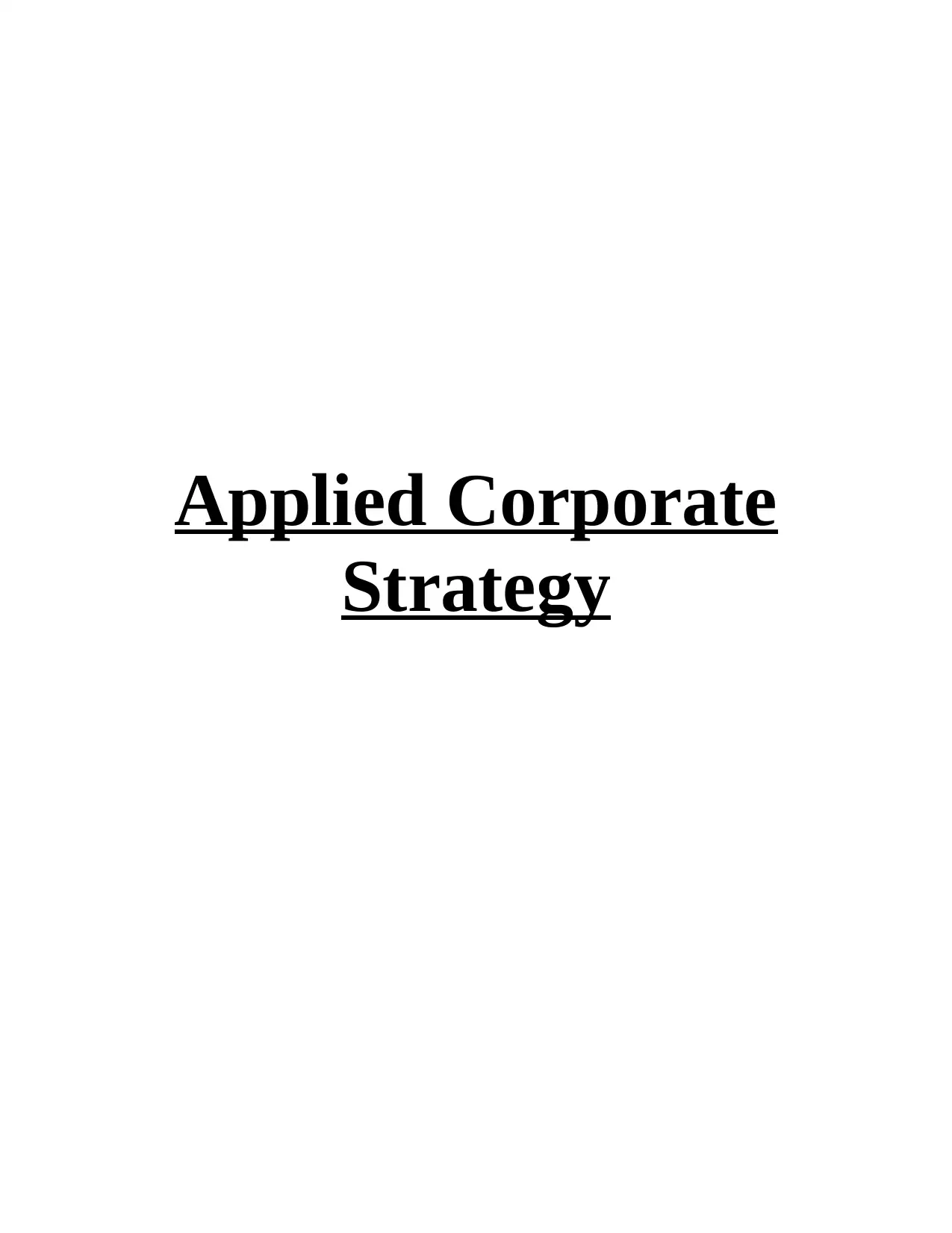
Applied Corporate
Strategy
Strategy
Secure Best Marks with AI Grader
Need help grading? Try our AI Grader for instant feedback on your assignments.
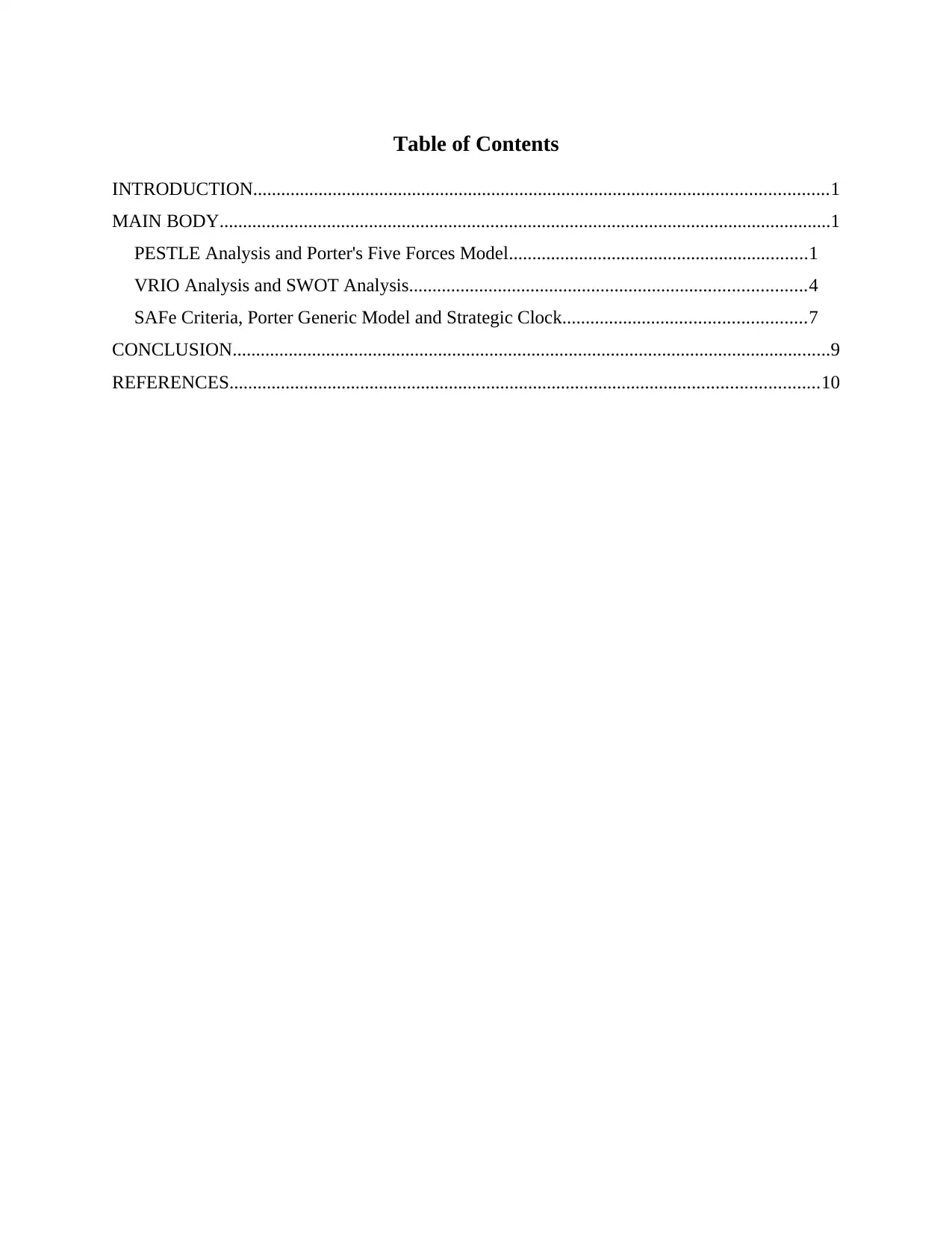
Table of Contents
INTRODUCTION...........................................................................................................................1
MAIN BODY...................................................................................................................................1
PESTLE Analysis and Porter's Five Forces Model................................................................1
VRIO Analysis and SWOT Analysis.....................................................................................4
SAFe Criteria, Porter Generic Model and Strategic Clock....................................................7
CONCLUSION................................................................................................................................9
REFERENCES..............................................................................................................................10
INTRODUCTION...........................................................................................................................1
MAIN BODY...................................................................................................................................1
PESTLE Analysis and Porter's Five Forces Model................................................................1
VRIO Analysis and SWOT Analysis.....................................................................................4
SAFe Criteria, Porter Generic Model and Strategic Clock....................................................7
CONCLUSION................................................................................................................................9
REFERENCES..............................................................................................................................10
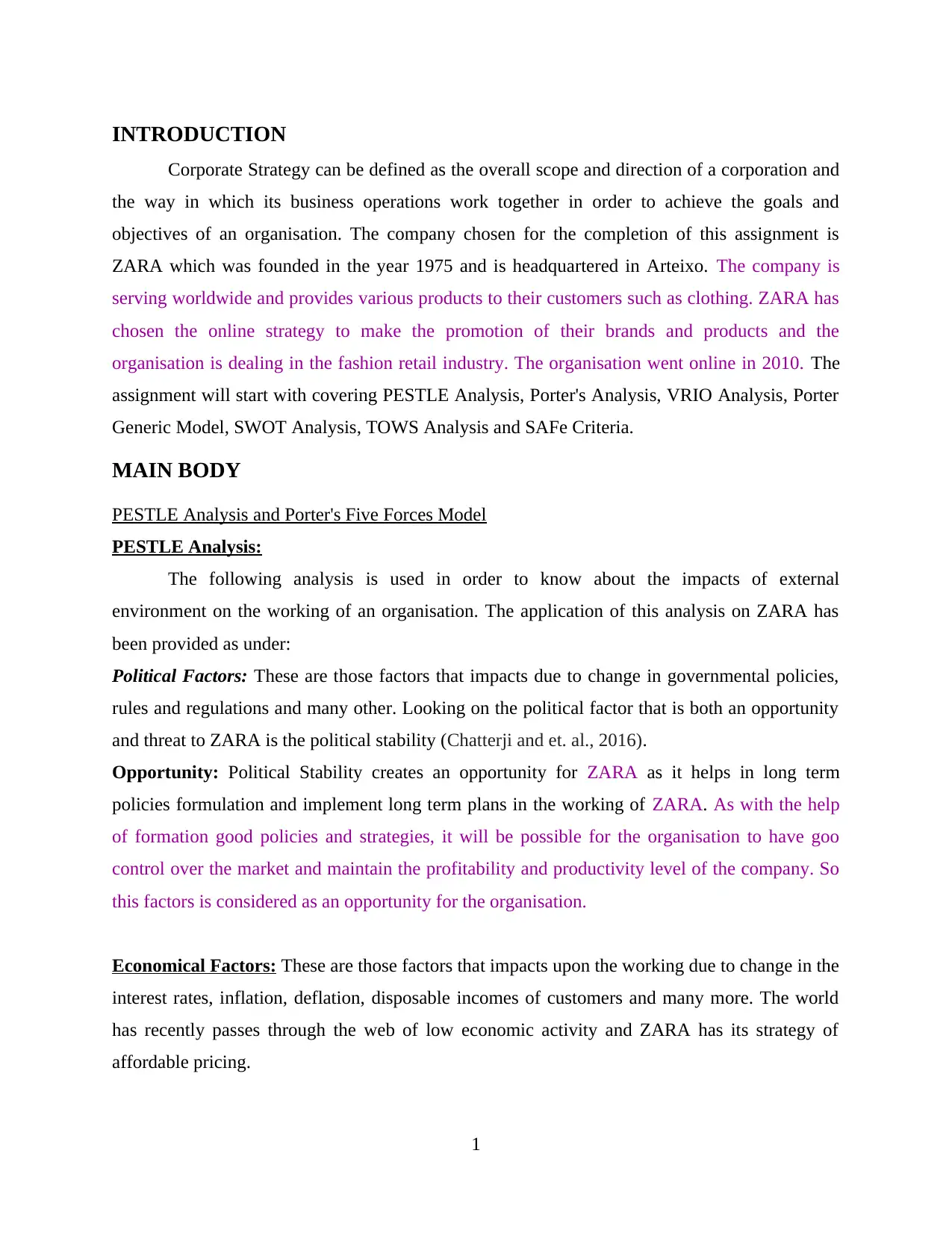
INTRODUCTION
Corporate Strategy can be defined as the overall scope and direction of a corporation and
the way in which its business operations work together in order to achieve the goals and
objectives of an organisation. The company chosen for the completion of this assignment is
ZARA which was founded in the year 1975 and is headquartered in Arteixo. The company is
serving worldwide and provides various products to their customers such as clothing. ZARA has
chosen the online strategy to make the promotion of their brands and products and the
organisation is dealing in the fashion retail industry. The organisation went online in 2010. The
assignment will start with covering PESTLE Analysis, Porter's Analysis, VRIO Analysis, Porter
Generic Model, SWOT Analysis, TOWS Analysis and SAFe Criteria.
MAIN BODY
PESTLE Analysis and Porter's Five Forces Model
PESTLE Analysis:
The following analysis is used in order to know about the impacts of external
environment on the working of an organisation. The application of this analysis on ZARA has
been provided as under:
Political Factors: These are those factors that impacts due to change in governmental policies,
rules and regulations and many other. Looking on the political factor that is both an opportunity
and threat to ZARA is the political stability (Chatterji and et. al., 2016).
Opportunity: Political Stability creates an opportunity for ZARA as it helps in long term
policies formulation and implement long term plans in the working of ZARA. As with the help
of formation good policies and strategies, it will be possible for the organisation to have goo
control over the market and maintain the profitability and productivity level of the company. So
this factors is considered as an opportunity for the organisation.
Economical Factors: These are those factors that impacts upon the working due to change in the
interest rates, inflation, deflation, disposable incomes of customers and many more. The world
has recently passes through the web of low economic activity and ZARA has its strategy of
affordable pricing.
1
Corporate Strategy can be defined as the overall scope and direction of a corporation and
the way in which its business operations work together in order to achieve the goals and
objectives of an organisation. The company chosen for the completion of this assignment is
ZARA which was founded in the year 1975 and is headquartered in Arteixo. The company is
serving worldwide and provides various products to their customers such as clothing. ZARA has
chosen the online strategy to make the promotion of their brands and products and the
organisation is dealing in the fashion retail industry. The organisation went online in 2010. The
assignment will start with covering PESTLE Analysis, Porter's Analysis, VRIO Analysis, Porter
Generic Model, SWOT Analysis, TOWS Analysis and SAFe Criteria.
MAIN BODY
PESTLE Analysis and Porter's Five Forces Model
PESTLE Analysis:
The following analysis is used in order to know about the impacts of external
environment on the working of an organisation. The application of this analysis on ZARA has
been provided as under:
Political Factors: These are those factors that impacts due to change in governmental policies,
rules and regulations and many other. Looking on the political factor that is both an opportunity
and threat to ZARA is the political stability (Chatterji and et. al., 2016).
Opportunity: Political Stability creates an opportunity for ZARA as it helps in long term
policies formulation and implement long term plans in the working of ZARA. As with the help
of formation good policies and strategies, it will be possible for the organisation to have goo
control over the market and maintain the profitability and productivity level of the company. So
this factors is considered as an opportunity for the organisation.
Economical Factors: These are those factors that impacts upon the working due to change in the
interest rates, inflation, deflation, disposable incomes of customers and many more. The world
has recently passes through the web of low economic activity and ZARA has its strategy of
affordable pricing.
1
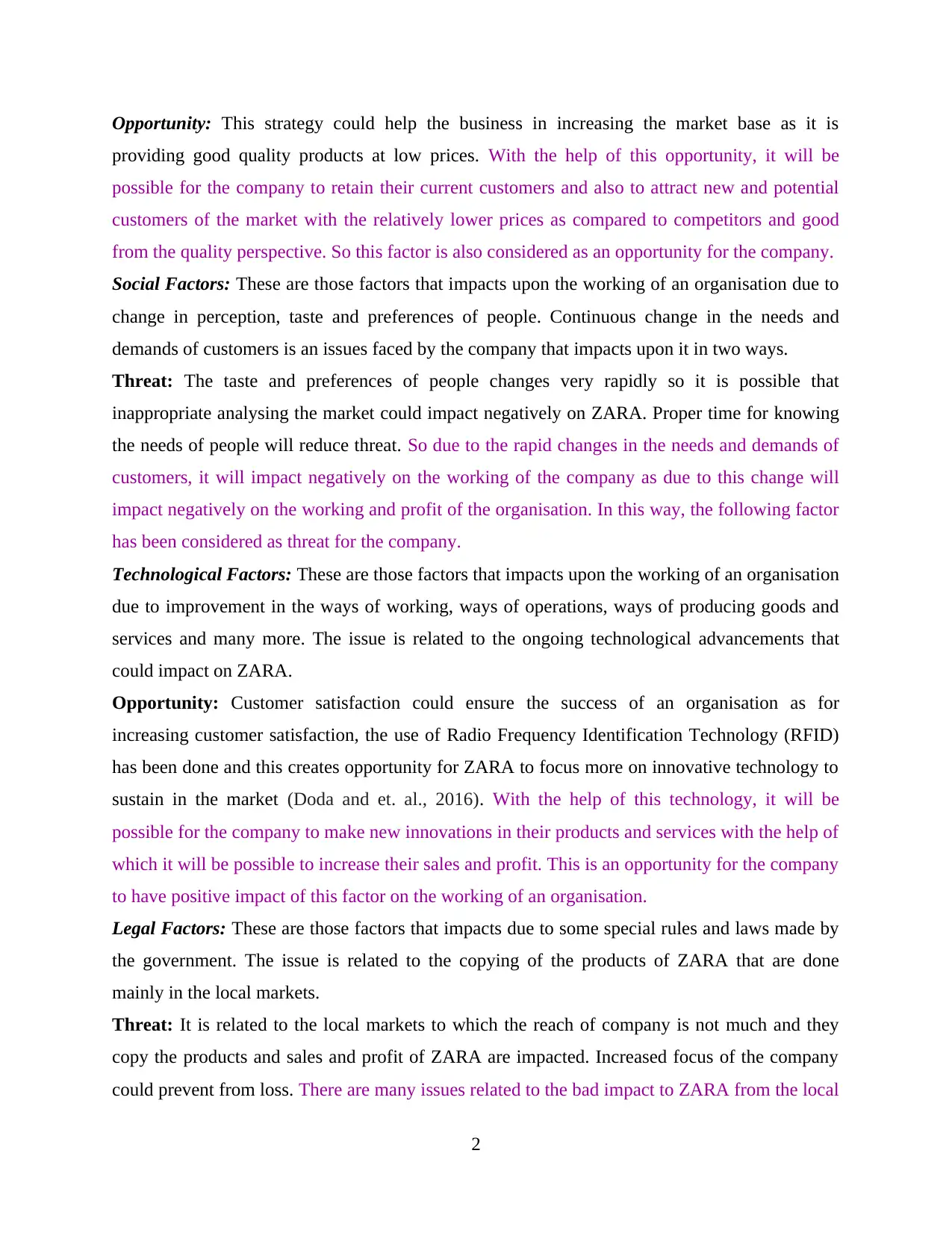
Opportunity: This strategy could help the business in increasing the market base as it is
providing good quality products at low prices. With the help of this opportunity, it will be
possible for the company to retain their current customers and also to attract new and potential
customers of the market with the relatively lower prices as compared to competitors and good
from the quality perspective. So this factor is also considered as an opportunity for the company.
Social Factors: These are those factors that impacts upon the working of an organisation due to
change in perception, taste and preferences of people. Continuous change in the needs and
demands of customers is an issues faced by the company that impacts upon it in two ways.
Threat: The taste and preferences of people changes very rapidly so it is possible that
inappropriate analysing the market could impact negatively on ZARA. Proper time for knowing
the needs of people will reduce threat. So due to the rapid changes in the needs and demands of
customers, it will impact negatively on the working of the company as due to this change will
impact negatively on the working and profit of the organisation. In this way, the following factor
has been considered as threat for the company.
Technological Factors: These are those factors that impacts upon the working of an organisation
due to improvement in the ways of working, ways of operations, ways of producing goods and
services and many more. The issue is related to the ongoing technological advancements that
could impact on ZARA.
Opportunity: Customer satisfaction could ensure the success of an organisation as for
increasing customer satisfaction, the use of Radio Frequency Identification Technology (RFID)
has been done and this creates opportunity for ZARA to focus more on innovative technology to
sustain in the market (Doda and et. al., 2016). With the help of this technology, it will be
possible for the company to make new innovations in their products and services with the help of
which it will be possible to increase their sales and profit. This is an opportunity for the company
to have positive impact of this factor on the working of an organisation.
Legal Factors: These are those factors that impacts due to some special rules and laws made by
the government. The issue is related to the copying of the products of ZARA that are done
mainly in the local markets.
Threat: It is related to the local markets to which the reach of company is not much and they
copy the products and sales and profit of ZARA are impacted. Increased focus of the company
could prevent from loss. There are many issues related to the bad impact to ZARA from the local
2
providing good quality products at low prices. With the help of this opportunity, it will be
possible for the company to retain their current customers and also to attract new and potential
customers of the market with the relatively lower prices as compared to competitors and good
from the quality perspective. So this factor is also considered as an opportunity for the company.
Social Factors: These are those factors that impacts upon the working of an organisation due to
change in perception, taste and preferences of people. Continuous change in the needs and
demands of customers is an issues faced by the company that impacts upon it in two ways.
Threat: The taste and preferences of people changes very rapidly so it is possible that
inappropriate analysing the market could impact negatively on ZARA. Proper time for knowing
the needs of people will reduce threat. So due to the rapid changes in the needs and demands of
customers, it will impact negatively on the working of the company as due to this change will
impact negatively on the working and profit of the organisation. In this way, the following factor
has been considered as threat for the company.
Technological Factors: These are those factors that impacts upon the working of an organisation
due to improvement in the ways of working, ways of operations, ways of producing goods and
services and many more. The issue is related to the ongoing technological advancements that
could impact on ZARA.
Opportunity: Customer satisfaction could ensure the success of an organisation as for
increasing customer satisfaction, the use of Radio Frequency Identification Technology (RFID)
has been done and this creates opportunity for ZARA to focus more on innovative technology to
sustain in the market (Doda and et. al., 2016). With the help of this technology, it will be
possible for the company to make new innovations in their products and services with the help of
which it will be possible to increase their sales and profit. This is an opportunity for the company
to have positive impact of this factor on the working of an organisation.
Legal Factors: These are those factors that impacts due to some special rules and laws made by
the government. The issue is related to the copying of the products of ZARA that are done
mainly in the local markets.
Threat: It is related to the local markets to which the reach of company is not much and they
copy the products and sales and profit of ZARA are impacted. Increased focus of the company
could prevent from loss. There are many issues related to the bad impact to ZARA from the local
2
Secure Best Marks with AI Grader
Need help grading? Try our AI Grader for instant feedback on your assignments.
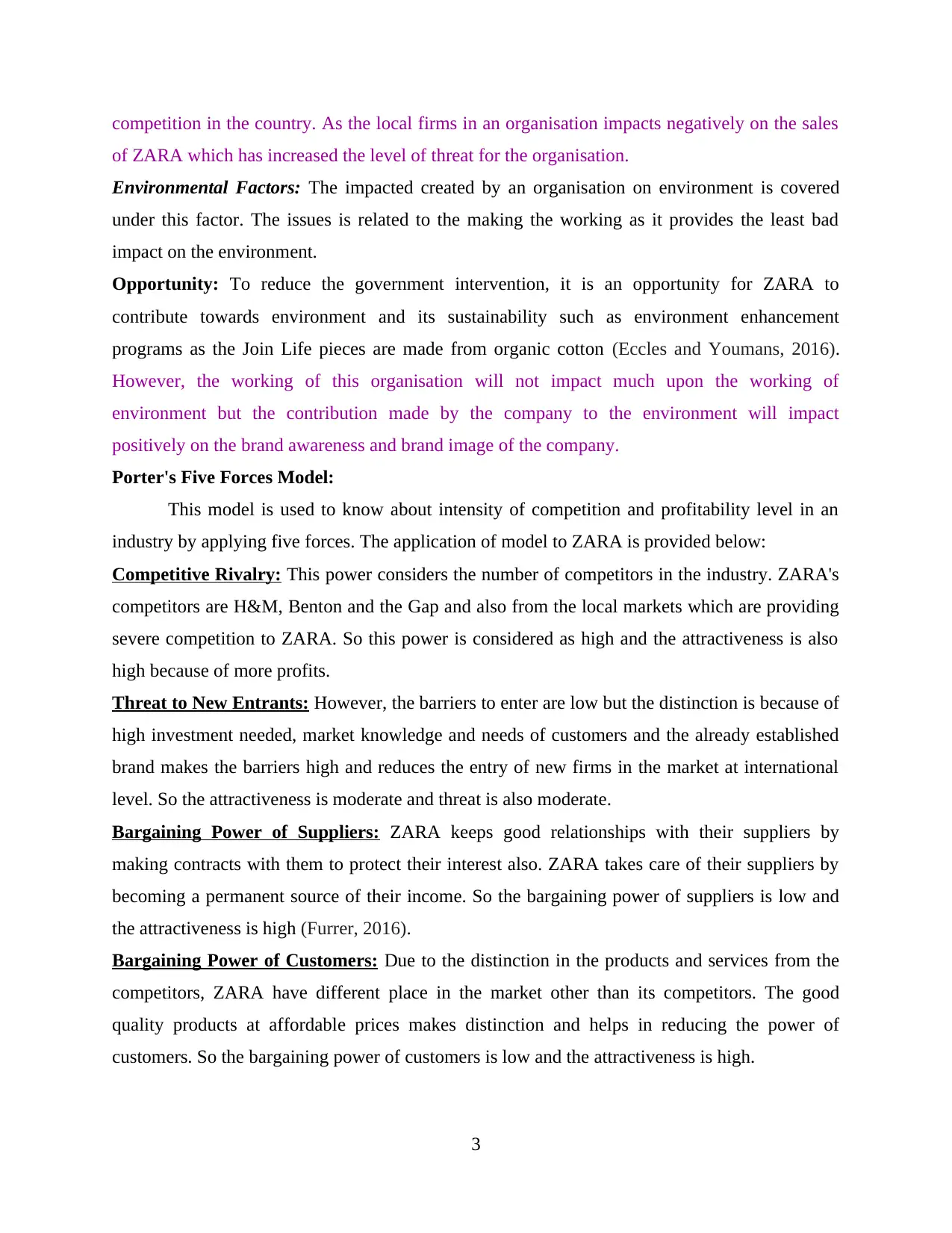
competition in the country. As the local firms in an organisation impacts negatively on the sales
of ZARA which has increased the level of threat for the organisation.
Environmental Factors: The impacted created by an organisation on environment is covered
under this factor. The issues is related to the making the working as it provides the least bad
impact on the environment.
Opportunity: To reduce the government intervention, it is an opportunity for ZARA to
contribute towards environment and its sustainability such as environment enhancement
programs as the Join Life pieces are made from organic cotton (Eccles and Youmans, 2016).
However, the working of this organisation will not impact much upon the working of
environment but the contribution made by the company to the environment will impact
positively on the brand awareness and brand image of the company.
Porter's Five Forces Model:
This model is used to know about intensity of competition and profitability level in an
industry by applying five forces. The application of model to ZARA is provided below:
Competitive Rivalry: This power considers the number of competitors in the industry. ZARA's
competitors are H&M, Benton and the Gap and also from the local markets which are providing
severe competition to ZARA. So this power is considered as high and the attractiveness is also
high because of more profits.
Threat to New Entrants: However, the barriers to enter are low but the distinction is because of
high investment needed, market knowledge and needs of customers and the already established
brand makes the barriers high and reduces the entry of new firms in the market at international
level. So the attractiveness is moderate and threat is also moderate.
Bargaining Power of Suppliers: ZARA keeps good relationships with their suppliers by
making contracts with them to protect their interest also. ZARA takes care of their suppliers by
becoming a permanent source of their income. So the bargaining power of suppliers is low and
the attractiveness is high (Furrer, 2016).
Bargaining Power of Customers: Due to the distinction in the products and services from the
competitors, ZARA have different place in the market other than its competitors. The good
quality products at affordable prices makes distinction and helps in reducing the power of
customers. So the bargaining power of customers is low and the attractiveness is high.
3
of ZARA which has increased the level of threat for the organisation.
Environmental Factors: The impacted created by an organisation on environment is covered
under this factor. The issues is related to the making the working as it provides the least bad
impact on the environment.
Opportunity: To reduce the government intervention, it is an opportunity for ZARA to
contribute towards environment and its sustainability such as environment enhancement
programs as the Join Life pieces are made from organic cotton (Eccles and Youmans, 2016).
However, the working of this organisation will not impact much upon the working of
environment but the contribution made by the company to the environment will impact
positively on the brand awareness and brand image of the company.
Porter's Five Forces Model:
This model is used to know about intensity of competition and profitability level in an
industry by applying five forces. The application of model to ZARA is provided below:
Competitive Rivalry: This power considers the number of competitors in the industry. ZARA's
competitors are H&M, Benton and the Gap and also from the local markets which are providing
severe competition to ZARA. So this power is considered as high and the attractiveness is also
high because of more profits.
Threat to New Entrants: However, the barriers to enter are low but the distinction is because of
high investment needed, market knowledge and needs of customers and the already established
brand makes the barriers high and reduces the entry of new firms in the market at international
level. So the attractiveness is moderate and threat is also moderate.
Bargaining Power of Suppliers: ZARA keeps good relationships with their suppliers by
making contracts with them to protect their interest also. ZARA takes care of their suppliers by
becoming a permanent source of their income. So the bargaining power of suppliers is low and
the attractiveness is high (Furrer, 2016).
Bargaining Power of Customers: Due to the distinction in the products and services from the
competitors, ZARA have different place in the market other than its competitors. The good
quality products at affordable prices makes distinction and helps in reducing the power of
customers. So the bargaining power of customers is low and the attractiveness is high.
3
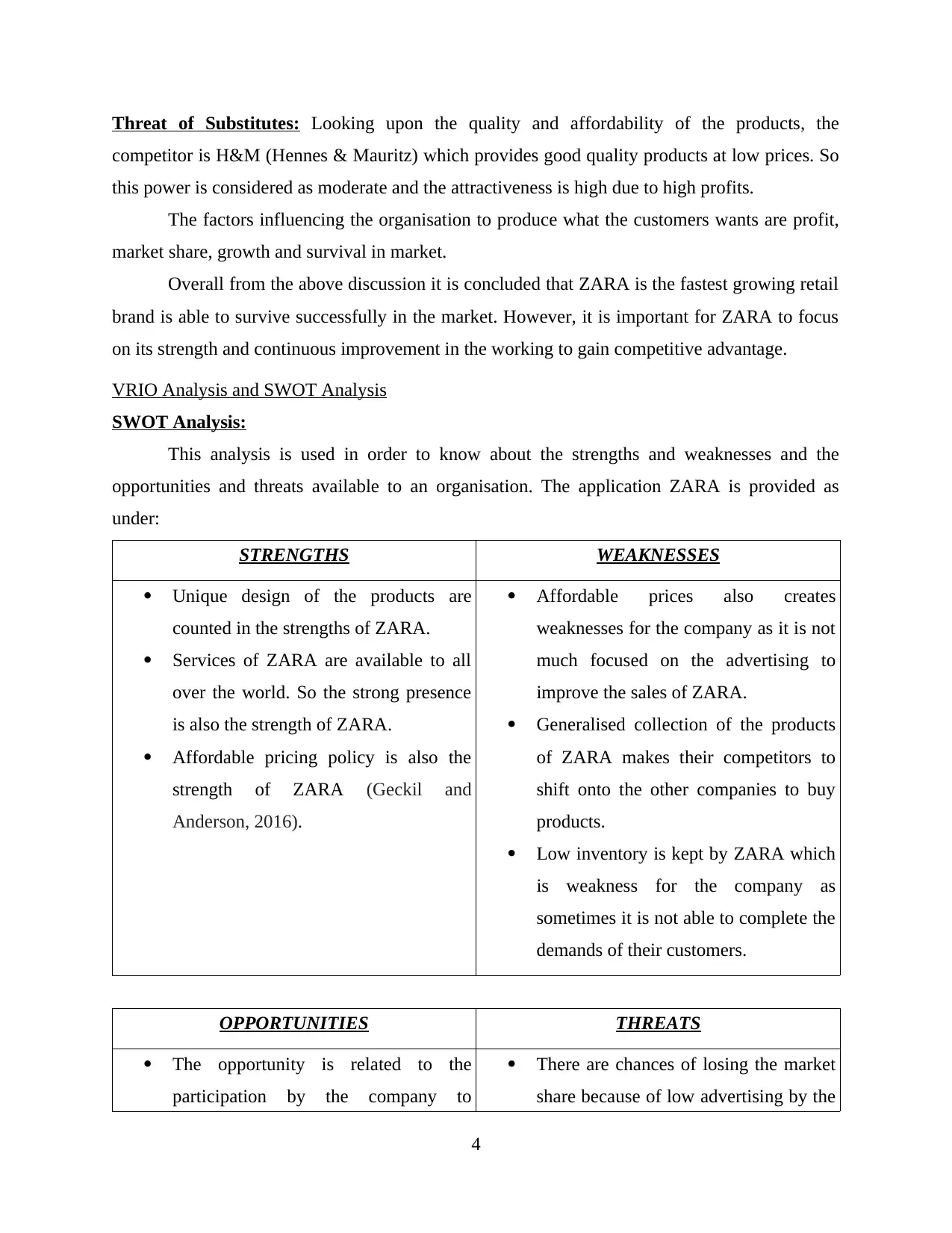
Threat of Substitutes: Looking upon the quality and affordability of the products, the
competitor is H&M (Hennes & Mauritz) which provides good quality products at low prices. So
this power is considered as moderate and the attractiveness is high due to high profits.
The factors influencing the organisation to produce what the customers wants are profit,
market share, growth and survival in market.
Overall from the above discussion it is concluded that ZARA is the fastest growing retail
brand is able to survive successfully in the market. However, it is important for ZARA to focus
on its strength and continuous improvement in the working to gain competitive advantage.
VRIO Analysis and SWOT Analysis
SWOT Analysis:
This analysis is used in order to know about the strengths and weaknesses and the
opportunities and threats available to an organisation. The application ZARA is provided as
under:
STRENGTHS WEAKNESSES
Unique design of the products are
counted in the strengths of ZARA.
Services of ZARA are available to all
over the world. So the strong presence
is also the strength of ZARA.
Affordable pricing policy is also the
strength of ZARA (Geckil and
Anderson, 2016).
Affordable prices also creates
weaknesses for the company as it is not
much focused on the advertising to
improve the sales of ZARA.
Generalised collection of the products
of ZARA makes their competitors to
shift onto the other companies to buy
products.
Low inventory is kept by ZARA which
is weakness for the company as
sometimes it is not able to complete the
demands of their customers.
OPPORTUNITIES THREATS
The opportunity is related to the
participation by the company to
There are chances of losing the market
share because of low advertising by the
4
competitor is H&M (Hennes & Mauritz) which provides good quality products at low prices. So
this power is considered as moderate and the attractiveness is high due to high profits.
The factors influencing the organisation to produce what the customers wants are profit,
market share, growth and survival in market.
Overall from the above discussion it is concluded that ZARA is the fastest growing retail
brand is able to survive successfully in the market. However, it is important for ZARA to focus
on its strength and continuous improvement in the working to gain competitive advantage.
VRIO Analysis and SWOT Analysis
SWOT Analysis:
This analysis is used in order to know about the strengths and weaknesses and the
opportunities and threats available to an organisation. The application ZARA is provided as
under:
STRENGTHS WEAKNESSES
Unique design of the products are
counted in the strengths of ZARA.
Services of ZARA are available to all
over the world. So the strong presence
is also the strength of ZARA.
Affordable pricing policy is also the
strength of ZARA (Geckil and
Anderson, 2016).
Affordable prices also creates
weaknesses for the company as it is not
much focused on the advertising to
improve the sales of ZARA.
Generalised collection of the products
of ZARA makes their competitors to
shift onto the other companies to buy
products.
Low inventory is kept by ZARA which
is weakness for the company as
sometimes it is not able to complete the
demands of their customers.
OPPORTUNITIES THREATS
The opportunity is related to the
participation by the company to
There are chances of losing the market
share because of low advertising by the
4
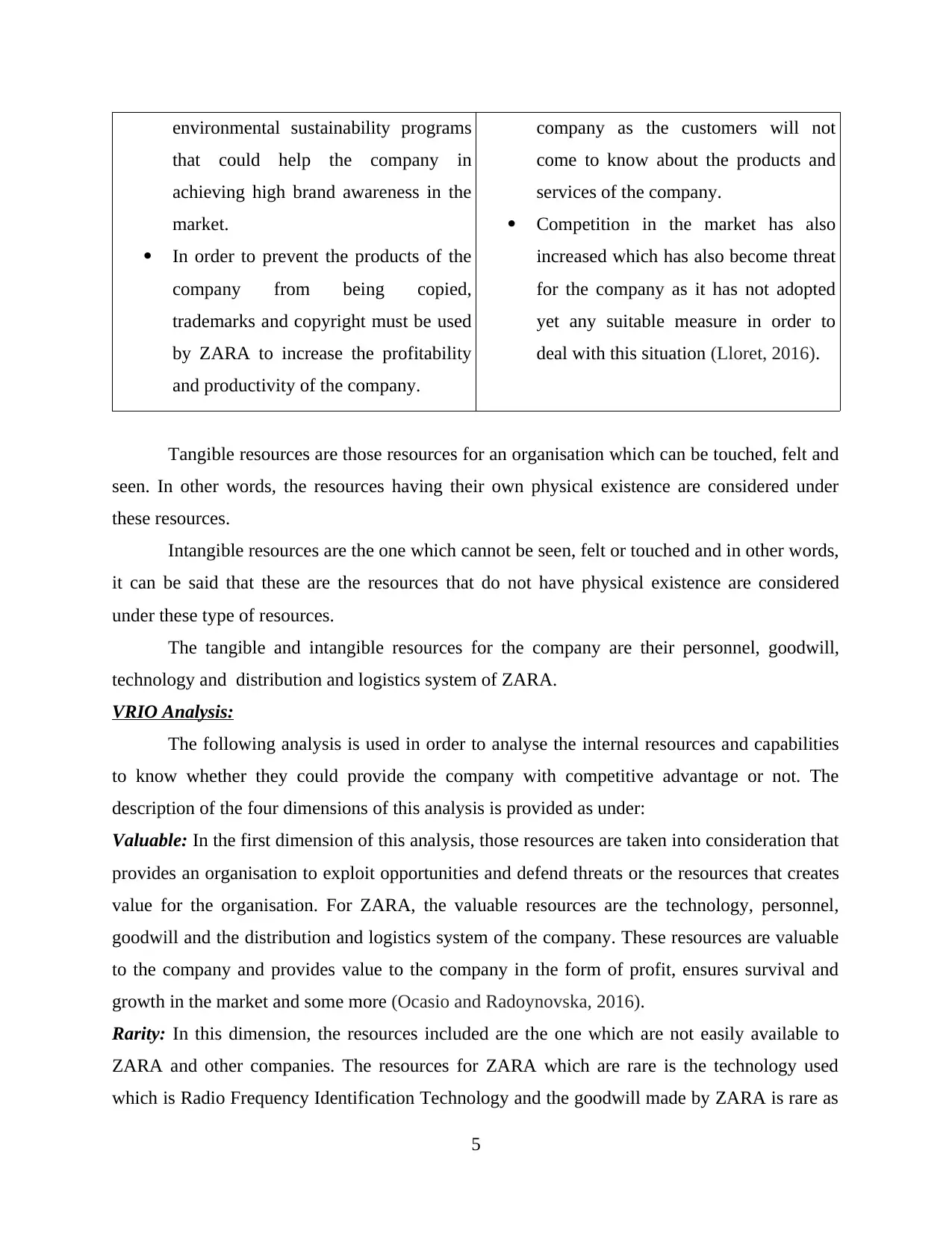
environmental sustainability programs
that could help the company in
achieving high brand awareness in the
market.
In order to prevent the products of the
company from being copied,
trademarks and copyright must be used
by ZARA to increase the profitability
and productivity of the company.
company as the customers will not
come to know about the products and
services of the company.
Competition in the market has also
increased which has also become threat
for the company as it has not adopted
yet any suitable measure in order to
deal with this situation (Lloret, 2016).
Tangible resources are those resources for an organisation which can be touched, felt and
seen. In other words, the resources having their own physical existence are considered under
these resources.
Intangible resources are the one which cannot be seen, felt or touched and in other words,
it can be said that these are the resources that do not have physical existence are considered
under these type of resources.
The tangible and intangible resources for the company are their personnel, goodwill,
technology and distribution and logistics system of ZARA.
VRIO Analysis:
The following analysis is used in order to analyse the internal resources and capabilities
to know whether they could provide the company with competitive advantage or not. The
description of the four dimensions of this analysis is provided as under:
Valuable: In the first dimension of this analysis, those resources are taken into consideration that
provides an organisation to exploit opportunities and defend threats or the resources that creates
value for the organisation. For ZARA, the valuable resources are the technology, personnel,
goodwill and the distribution and logistics system of the company. These resources are valuable
to the company and provides value to the company in the form of profit, ensures survival and
growth in the market and some more (Ocasio and Radoynovska, 2016).
Rarity: In this dimension, the resources included are the one which are not easily available to
ZARA and other companies. The resources for ZARA which are rare is the technology used
which is Radio Frequency Identification Technology and the goodwill made by ZARA is rare as
5
that could help the company in
achieving high brand awareness in the
market.
In order to prevent the products of the
company from being copied,
trademarks and copyright must be used
by ZARA to increase the profitability
and productivity of the company.
company as the customers will not
come to know about the products and
services of the company.
Competition in the market has also
increased which has also become threat
for the company as it has not adopted
yet any suitable measure in order to
deal with this situation (Lloret, 2016).
Tangible resources are those resources for an organisation which can be touched, felt and
seen. In other words, the resources having their own physical existence are considered under
these resources.
Intangible resources are the one which cannot be seen, felt or touched and in other words,
it can be said that these are the resources that do not have physical existence are considered
under these type of resources.
The tangible and intangible resources for the company are their personnel, goodwill,
technology and distribution and logistics system of ZARA.
VRIO Analysis:
The following analysis is used in order to analyse the internal resources and capabilities
to know whether they could provide the company with competitive advantage or not. The
description of the four dimensions of this analysis is provided as under:
Valuable: In the first dimension of this analysis, those resources are taken into consideration that
provides an organisation to exploit opportunities and defend threats or the resources that creates
value for the organisation. For ZARA, the valuable resources are the technology, personnel,
goodwill and the distribution and logistics system of the company. These resources are valuable
to the company and provides value to the company in the form of profit, ensures survival and
growth in the market and some more (Ocasio and Radoynovska, 2016).
Rarity: In this dimension, the resources included are the one which are not easily available to
ZARA and other companies. The resources for ZARA which are rare is the technology used
which is Radio Frequency Identification Technology and the goodwill made by ZARA is rare as
5
Paraphrase This Document
Need a fresh take? Get an instant paraphrase of this document with our AI Paraphraser
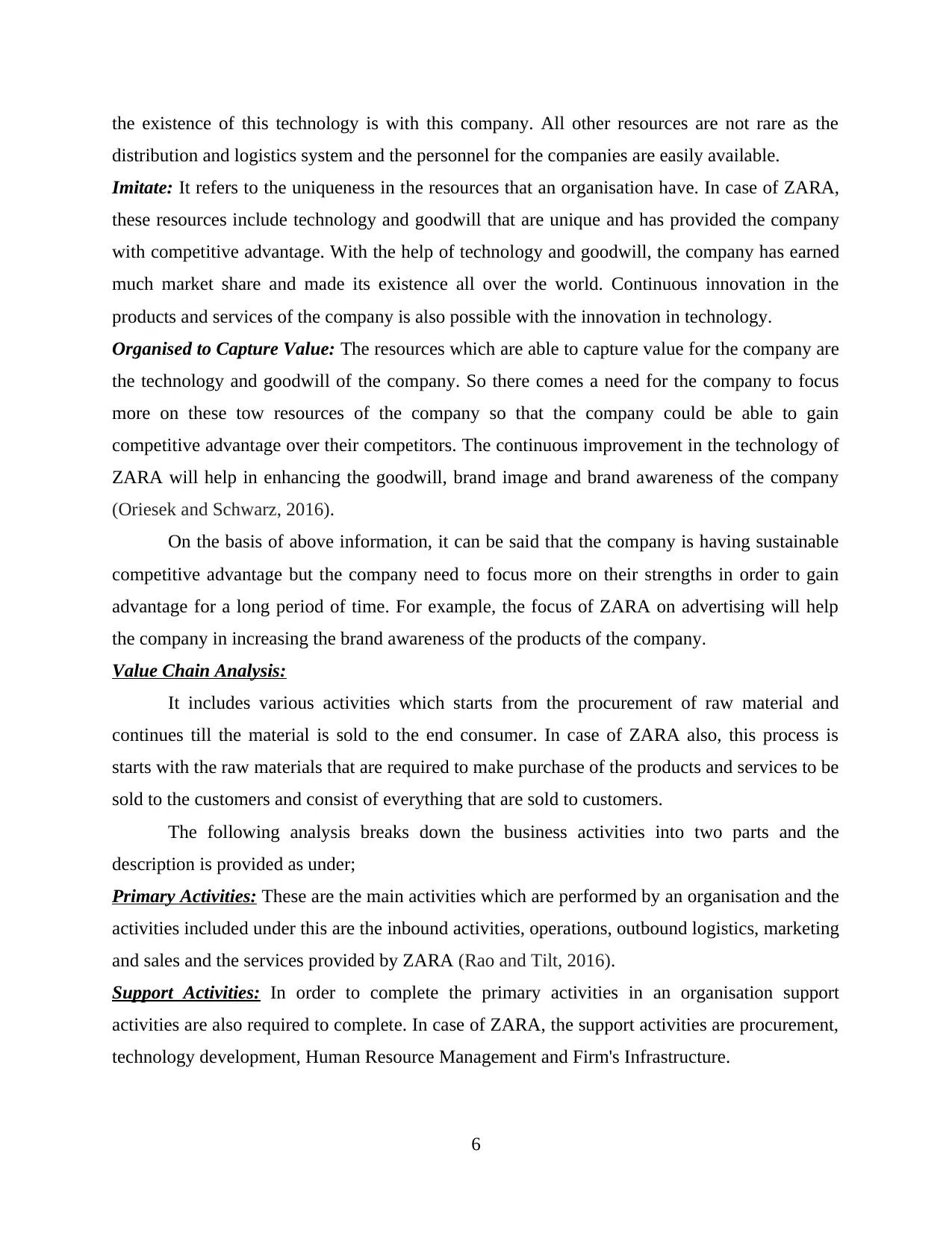
the existence of this technology is with this company. All other resources are not rare as the
distribution and logistics system and the personnel for the companies are easily available.
Imitate: It refers to the uniqueness in the resources that an organisation have. In case of ZARA,
these resources include technology and goodwill that are unique and has provided the company
with competitive advantage. With the help of technology and goodwill, the company has earned
much market share and made its existence all over the world. Continuous innovation in the
products and services of the company is also possible with the innovation in technology.
Organised to Capture Value: The resources which are able to capture value for the company are
the technology and goodwill of the company. So there comes a need for the company to focus
more on these tow resources of the company so that the company could be able to gain
competitive advantage over their competitors. The continuous improvement in the technology of
ZARA will help in enhancing the goodwill, brand image and brand awareness of the company
(Oriesek and Schwarz, 2016).
On the basis of above information, it can be said that the company is having sustainable
competitive advantage but the company need to focus more on their strengths in order to gain
advantage for a long period of time. For example, the focus of ZARA on advertising will help
the company in increasing the brand awareness of the products of the company.
Value Chain Analysis:
It includes various activities which starts from the procurement of raw material and
continues till the material is sold to the end consumer. In case of ZARA also, this process is
starts with the raw materials that are required to make purchase of the products and services to be
sold to the customers and consist of everything that are sold to customers.
The following analysis breaks down the business activities into two parts and the
description is provided as under;
Primary Activities: These are the main activities which are performed by an organisation and the
activities included under this are the inbound activities, operations, outbound logistics, marketing
and sales and the services provided by ZARA (Rao and Tilt, 2016).
Support Activities: In order to complete the primary activities in an organisation support
activities are also required to complete. In case of ZARA, the support activities are procurement,
technology development, Human Resource Management and Firm's Infrastructure.
6
distribution and logistics system and the personnel for the companies are easily available.
Imitate: It refers to the uniqueness in the resources that an organisation have. In case of ZARA,
these resources include technology and goodwill that are unique and has provided the company
with competitive advantage. With the help of technology and goodwill, the company has earned
much market share and made its existence all over the world. Continuous innovation in the
products and services of the company is also possible with the innovation in technology.
Organised to Capture Value: The resources which are able to capture value for the company are
the technology and goodwill of the company. So there comes a need for the company to focus
more on these tow resources of the company so that the company could be able to gain
competitive advantage over their competitors. The continuous improvement in the technology of
ZARA will help in enhancing the goodwill, brand image and brand awareness of the company
(Oriesek and Schwarz, 2016).
On the basis of above information, it can be said that the company is having sustainable
competitive advantage but the company need to focus more on their strengths in order to gain
advantage for a long period of time. For example, the focus of ZARA on advertising will help
the company in increasing the brand awareness of the products of the company.
Value Chain Analysis:
It includes various activities which starts from the procurement of raw material and
continues till the material is sold to the end consumer. In case of ZARA also, this process is
starts with the raw materials that are required to make purchase of the products and services to be
sold to the customers and consist of everything that are sold to customers.
The following analysis breaks down the business activities into two parts and the
description is provided as under;
Primary Activities: These are the main activities which are performed by an organisation and the
activities included under this are the inbound activities, operations, outbound logistics, marketing
and sales and the services provided by ZARA (Rao and Tilt, 2016).
Support Activities: In order to complete the primary activities in an organisation support
activities are also required to complete. In case of ZARA, the support activities are procurement,
technology development, Human Resource Management and Firm's Infrastructure.
6
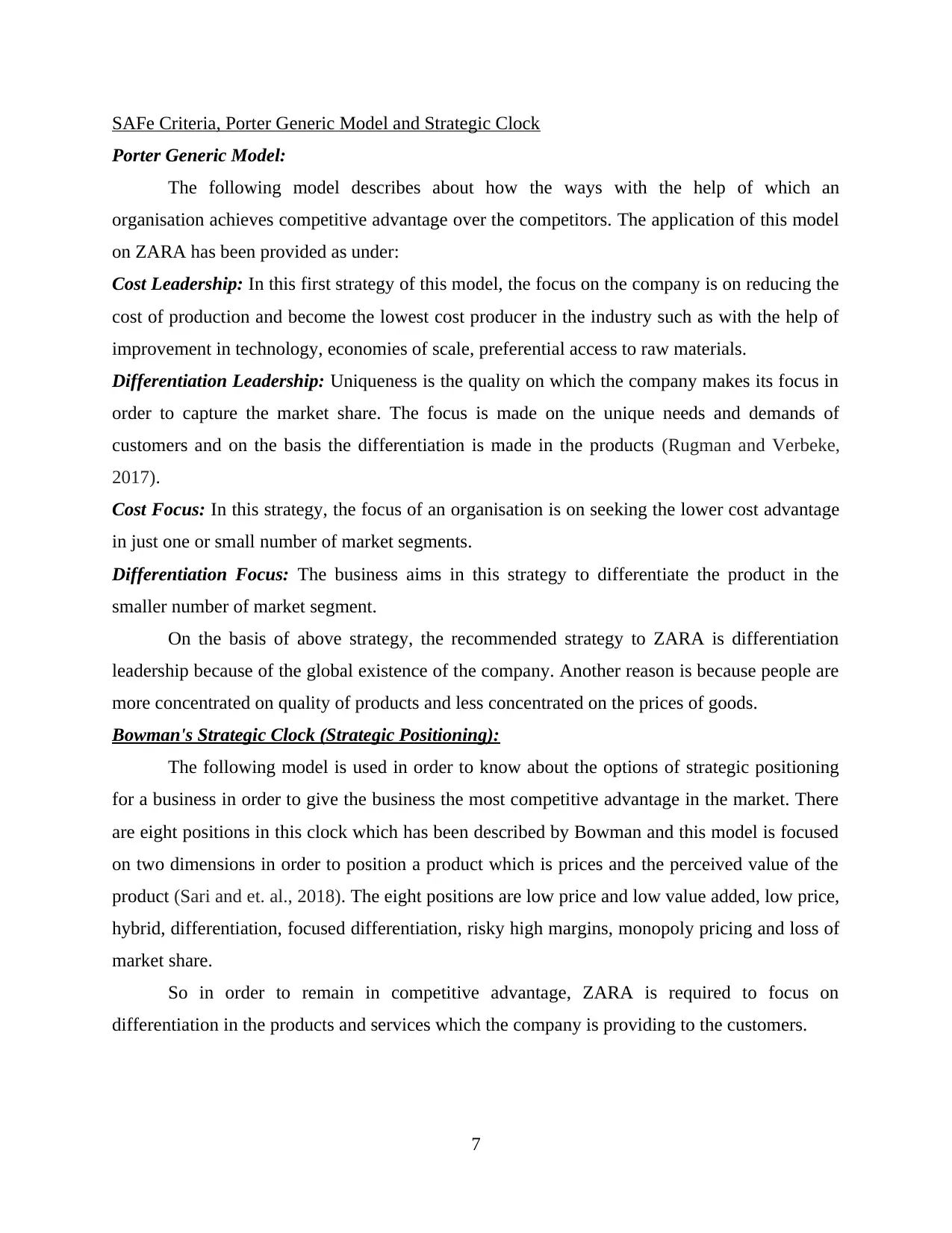
SAFe Criteria, Porter Generic Model and Strategic Clock
Porter Generic Model:
The following model describes about how the ways with the help of which an
organisation achieves competitive advantage over the competitors. The application of this model
on ZARA has been provided as under:
Cost Leadership: In this first strategy of this model, the focus on the company is on reducing the
cost of production and become the lowest cost producer in the industry such as with the help of
improvement in technology, economies of scale, preferential access to raw materials.
Differentiation Leadership: Uniqueness is the quality on which the company makes its focus in
order to capture the market share. The focus is made on the unique needs and demands of
customers and on the basis the differentiation is made in the products (Rugman and Verbeke,
2017).
Cost Focus: In this strategy, the focus of an organisation is on seeking the lower cost advantage
in just one or small number of market segments.
Differentiation Focus: The business aims in this strategy to differentiate the product in the
smaller number of market segment.
On the basis of above strategy, the recommended strategy to ZARA is differentiation
leadership because of the global existence of the company. Another reason is because people are
more concentrated on quality of products and less concentrated on the prices of goods.
Bowman's Strategic Clock (Strategic Positioning):
The following model is used in order to know about the options of strategic positioning
for a business in order to give the business the most competitive advantage in the market. There
are eight positions in this clock which has been described by Bowman and this model is focused
on two dimensions in order to position a product which is prices and the perceived value of the
product (Sari and et. al., 2018). The eight positions are low price and low value added, low price,
hybrid, differentiation, focused differentiation, risky high margins, monopoly pricing and loss of
market share.
So in order to remain in competitive advantage, ZARA is required to focus on
differentiation in the products and services which the company is providing to the customers.
7
Porter Generic Model:
The following model describes about how the ways with the help of which an
organisation achieves competitive advantage over the competitors. The application of this model
on ZARA has been provided as under:
Cost Leadership: In this first strategy of this model, the focus on the company is on reducing the
cost of production and become the lowest cost producer in the industry such as with the help of
improvement in technology, economies of scale, preferential access to raw materials.
Differentiation Leadership: Uniqueness is the quality on which the company makes its focus in
order to capture the market share. The focus is made on the unique needs and demands of
customers and on the basis the differentiation is made in the products (Rugman and Verbeke,
2017).
Cost Focus: In this strategy, the focus of an organisation is on seeking the lower cost advantage
in just one or small number of market segments.
Differentiation Focus: The business aims in this strategy to differentiate the product in the
smaller number of market segment.
On the basis of above strategy, the recommended strategy to ZARA is differentiation
leadership because of the global existence of the company. Another reason is because people are
more concentrated on quality of products and less concentrated on the prices of goods.
Bowman's Strategic Clock (Strategic Positioning):
The following model is used in order to know about the options of strategic positioning
for a business in order to give the business the most competitive advantage in the market. There
are eight positions in this clock which has been described by Bowman and this model is focused
on two dimensions in order to position a product which is prices and the perceived value of the
product (Sari and et. al., 2018). The eight positions are low price and low value added, low price,
hybrid, differentiation, focused differentiation, risky high margins, monopoly pricing and loss of
market share.
So in order to remain in competitive advantage, ZARA is required to focus on
differentiation in the products and services which the company is providing to the customers.
7

It is important for the companies to be in competitive advantage that their competitors
because with the help of this situation it will be possible for companies to give competition to
their competitors and earn sufficient profit and market share for the growth and survival.
Strategic Direction: The strategic directions will be provided to ZARA by making use of Ansoff
Matrix and these direction are provided as under:
Product Development: In this direction, the company makes innovation in their current products
and sells them in the existing markets.
Market Development: In this direction, the company sells their existing products in the new
markets.
Market Penetration: In this direction, the existing products and services of an organisation are
sold in the current markets by making use of advertisement tools (Shaukat, Qiu and Trojanowski,
2016).
Diversification: In this strategy, an organisation sells new products in the new markets.
The strategic direction suggested to ZARA is diversification because of the already
established good brand image, it will be easy for the companies to capture the market share and
increase its customer base and sources of revenue and incomes.
Corporate Parenting:
The following term for ZARA can be defined as the parent company for an organisation.
In case of ZARA, the parent company is Inditex and all the senior managers who are responsible
for defining the overall corporate strategy of an organisation.
Portfolio Management:
It can be defined as the art of making the decisions related to the investment mix and
policies, matching investment to objectives and balancing the risk performance. In case of
ZARA also the company has invested the money at many places to manage the risk as in some
place, the company may lose the investment but in some, ZARA will earn.
Strategic Methods:
The strategic methods adopted by ZARA are Porter's Five Forces model, Porter's Generic
Model, Ansoff Matrix and Forecasting has been done by ZARA.
SWOT Re-Visited and TOWS Analysis:
Strengths and Opportunities: The unique products and design of the products of ZARA creates
opportunity for ZARA to save it from being copied and will provide the company with
8
because with the help of this situation it will be possible for companies to give competition to
their competitors and earn sufficient profit and market share for the growth and survival.
Strategic Direction: The strategic directions will be provided to ZARA by making use of Ansoff
Matrix and these direction are provided as under:
Product Development: In this direction, the company makes innovation in their current products
and sells them in the existing markets.
Market Development: In this direction, the company sells their existing products in the new
markets.
Market Penetration: In this direction, the existing products and services of an organisation are
sold in the current markets by making use of advertisement tools (Shaukat, Qiu and Trojanowski,
2016).
Diversification: In this strategy, an organisation sells new products in the new markets.
The strategic direction suggested to ZARA is diversification because of the already
established good brand image, it will be easy for the companies to capture the market share and
increase its customer base and sources of revenue and incomes.
Corporate Parenting:
The following term for ZARA can be defined as the parent company for an organisation.
In case of ZARA, the parent company is Inditex and all the senior managers who are responsible
for defining the overall corporate strategy of an organisation.
Portfolio Management:
It can be defined as the art of making the decisions related to the investment mix and
policies, matching investment to objectives and balancing the risk performance. In case of
ZARA also the company has invested the money at many places to manage the risk as in some
place, the company may lose the investment but in some, ZARA will earn.
Strategic Methods:
The strategic methods adopted by ZARA are Porter's Five Forces model, Porter's Generic
Model, Ansoff Matrix and Forecasting has been done by ZARA.
SWOT Re-Visited and TOWS Analysis:
Strengths and Opportunities: The unique products and design of the products of ZARA creates
opportunity for ZARA to save it from being copied and will provide the company with
8
Secure Best Marks with AI Grader
Need help grading? Try our AI Grader for instant feedback on your assignments.
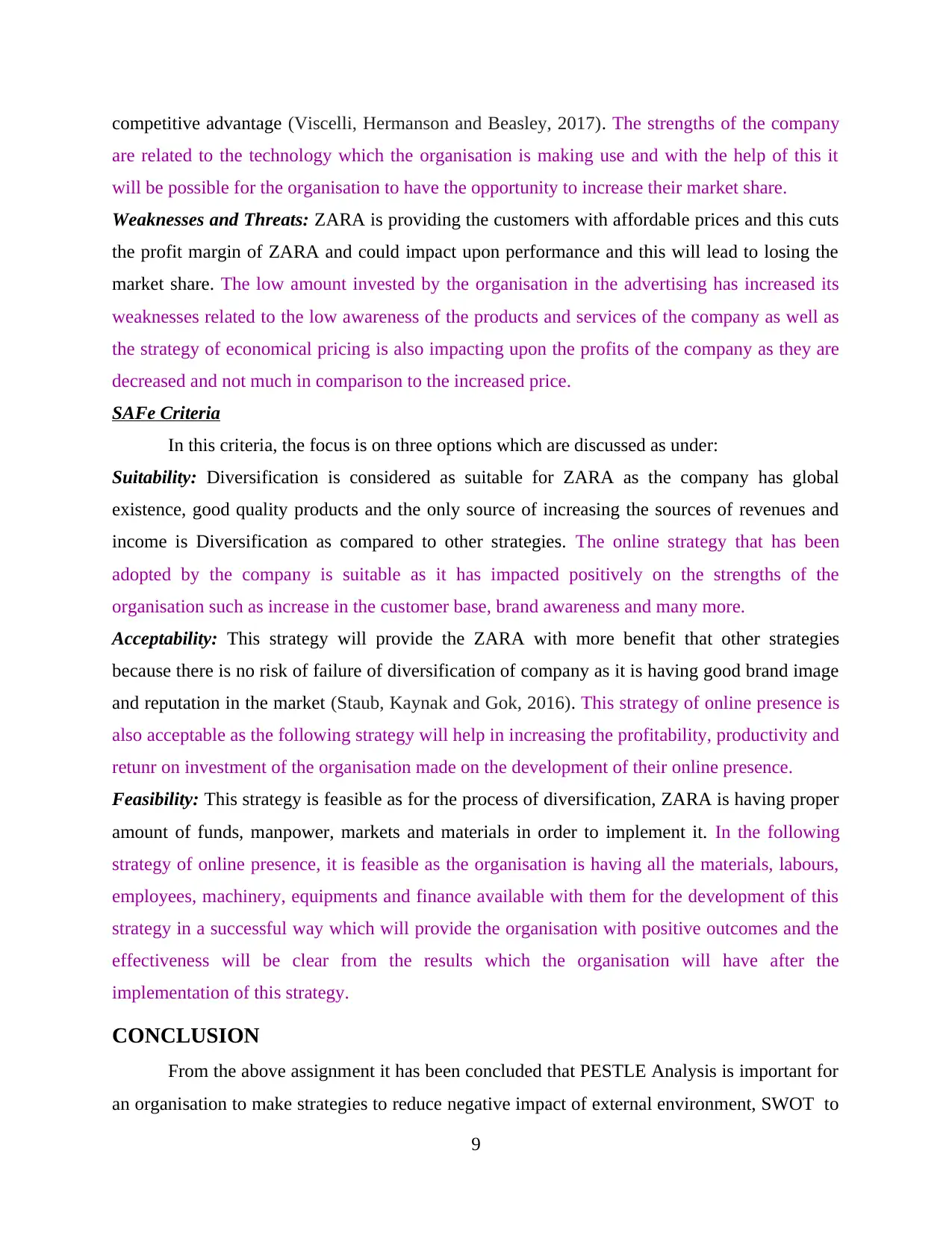
competitive advantage (Viscelli, Hermanson and Beasley, 2017). The strengths of the company
are related to the technology which the organisation is making use and with the help of this it
will be possible for the organisation to have the opportunity to increase their market share.
Weaknesses and Threats: ZARA is providing the customers with affordable prices and this cuts
the profit margin of ZARA and could impact upon performance and this will lead to losing the
market share. The low amount invested by the organisation in the advertising has increased its
weaknesses related to the low awareness of the products and services of the company as well as
the strategy of economical pricing is also impacting upon the profits of the company as they are
decreased and not much in comparison to the increased price.
SAFe Criteria
In this criteria, the focus is on three options which are discussed as under:
Suitability: Diversification is considered as suitable for ZARA as the company has global
existence, good quality products and the only source of increasing the sources of revenues and
income is Diversification as compared to other strategies. The online strategy that has been
adopted by the company is suitable as it has impacted positively on the strengths of the
organisation such as increase in the customer base, brand awareness and many more.
Acceptability: This strategy will provide the ZARA with more benefit that other strategies
because there is no risk of failure of diversification of company as it is having good brand image
and reputation in the market (Staub, Kaynak and Gok, 2016). This strategy of online presence is
also acceptable as the following strategy will help in increasing the profitability, productivity and
retunr on investment of the organisation made on the development of their online presence.
Feasibility: This strategy is feasible as for the process of diversification, ZARA is having proper
amount of funds, manpower, markets and materials in order to implement it. In the following
strategy of online presence, it is feasible as the organisation is having all the materials, labours,
employees, machinery, equipments and finance available with them for the development of this
strategy in a successful way which will provide the organisation with positive outcomes and the
effectiveness will be clear from the results which the organisation will have after the
implementation of this strategy.
CONCLUSION
From the above assignment it has been concluded that PESTLE Analysis is important for
an organisation to make strategies to reduce negative impact of external environment, SWOT to
9
are related to the technology which the organisation is making use and with the help of this it
will be possible for the organisation to have the opportunity to increase their market share.
Weaknesses and Threats: ZARA is providing the customers with affordable prices and this cuts
the profit margin of ZARA and could impact upon performance and this will lead to losing the
market share. The low amount invested by the organisation in the advertising has increased its
weaknesses related to the low awareness of the products and services of the company as well as
the strategy of economical pricing is also impacting upon the profits of the company as they are
decreased and not much in comparison to the increased price.
SAFe Criteria
In this criteria, the focus is on three options which are discussed as under:
Suitability: Diversification is considered as suitable for ZARA as the company has global
existence, good quality products and the only source of increasing the sources of revenues and
income is Diversification as compared to other strategies. The online strategy that has been
adopted by the company is suitable as it has impacted positively on the strengths of the
organisation such as increase in the customer base, brand awareness and many more.
Acceptability: This strategy will provide the ZARA with more benefit that other strategies
because there is no risk of failure of diversification of company as it is having good brand image
and reputation in the market (Staub, Kaynak and Gok, 2016). This strategy of online presence is
also acceptable as the following strategy will help in increasing the profitability, productivity and
retunr on investment of the organisation made on the development of their online presence.
Feasibility: This strategy is feasible as for the process of diversification, ZARA is having proper
amount of funds, manpower, markets and materials in order to implement it. In the following
strategy of online presence, it is feasible as the organisation is having all the materials, labours,
employees, machinery, equipments and finance available with them for the development of this
strategy in a successful way which will provide the organisation with positive outcomes and the
effectiveness will be clear from the results which the organisation will have after the
implementation of this strategy.
CONCLUSION
From the above assignment it has been concluded that PESTLE Analysis is important for
an organisation to make strategies to reduce negative impact of external environment, SWOT to
9
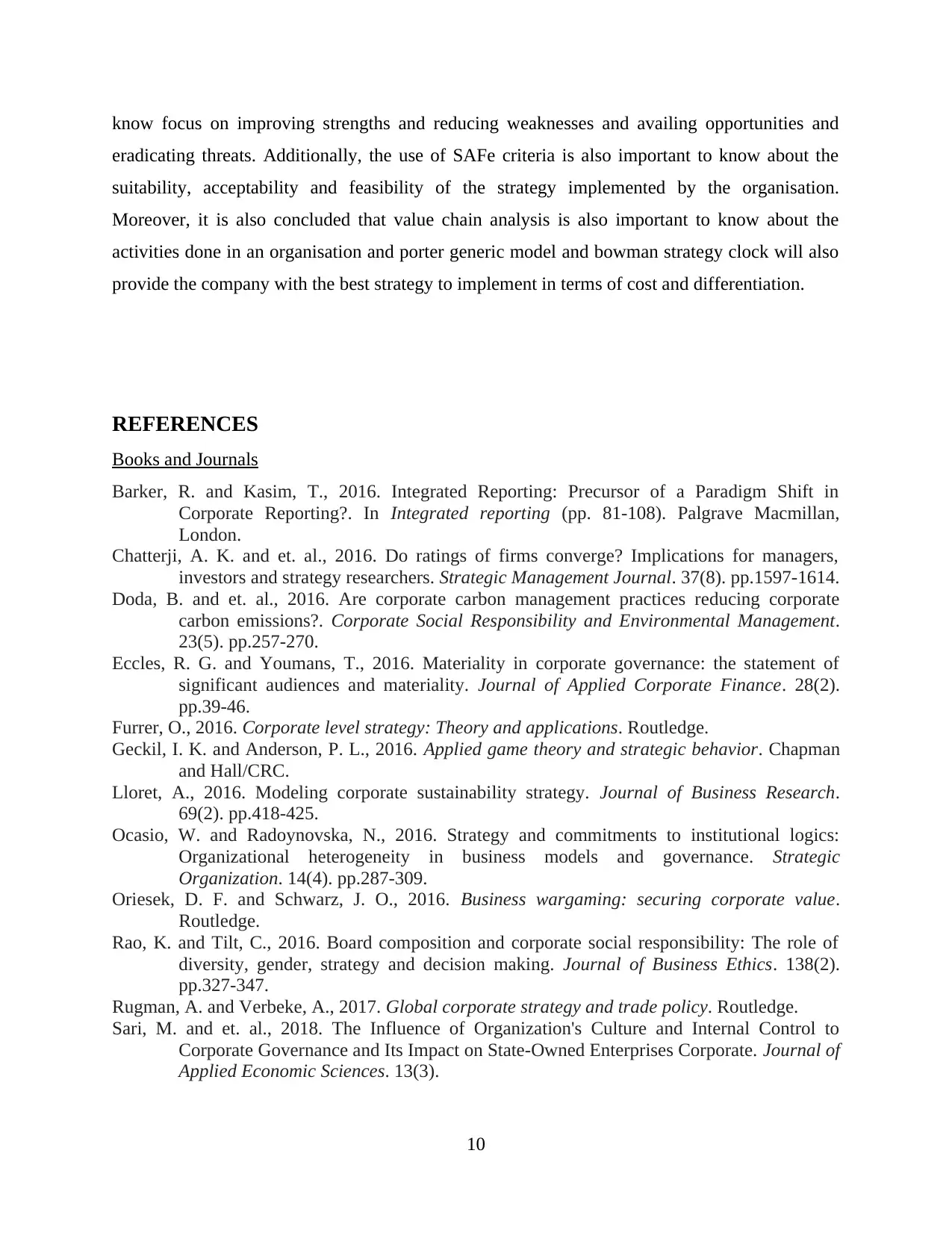
know focus on improving strengths and reducing weaknesses and availing opportunities and
eradicating threats. Additionally, the use of SAFe criteria is also important to know about the
suitability, acceptability and feasibility of the strategy implemented by the organisation.
Moreover, it is also concluded that value chain analysis is also important to know about the
activities done in an organisation and porter generic model and bowman strategy clock will also
provide the company with the best strategy to implement in terms of cost and differentiation.
REFERENCES
Books and Journals
Barker, R. and Kasim, T., 2016. Integrated Reporting: Precursor of a Paradigm Shift in
Corporate Reporting?. In Integrated reporting (pp. 81-108). Palgrave Macmillan,
London.
Chatterji, A. K. and et. al., 2016. Do ratings of firms converge? Implications for managers,
investors and strategy researchers. Strategic Management Journal. 37(8). pp.1597-1614.
Doda, B. and et. al., 2016. Are corporate carbon management practices reducing corporate
carbon emissions?. Corporate Social Responsibility and Environmental Management.
23(5). pp.257-270.
Eccles, R. G. and Youmans, T., 2016. Materiality in corporate governance: the statement of
significant audiences and materiality. Journal of Applied Corporate Finance. 28(2).
pp.39-46.
Furrer, O., 2016. Corporate level strategy: Theory and applications. Routledge.
Geckil, I. K. and Anderson, P. L., 2016. Applied game theory and strategic behavior. Chapman
and Hall/CRC.
Lloret, A., 2016. Modeling corporate sustainability strategy. Journal of Business Research.
69(2). pp.418-425.
Ocasio, W. and Radoynovska, N., 2016. Strategy and commitments to institutional logics:
Organizational heterogeneity in business models and governance. Strategic
Organization. 14(4). pp.287-309.
Oriesek, D. F. and Schwarz, J. O., 2016. Business wargaming: securing corporate value.
Routledge.
Rao, K. and Tilt, C., 2016. Board composition and corporate social responsibility: The role of
diversity, gender, strategy and decision making. Journal of Business Ethics. 138(2).
pp.327-347.
Rugman, A. and Verbeke, A., 2017. Global corporate strategy and trade policy. Routledge.
Sari, M. and et. al., 2018. The Influence of Organization's Culture and Internal Control to
Corporate Governance and Its Impact on State-Owned Enterprises Corporate. Journal of
Applied Economic Sciences. 13(3).
10
eradicating threats. Additionally, the use of SAFe criteria is also important to know about the
suitability, acceptability and feasibility of the strategy implemented by the organisation.
Moreover, it is also concluded that value chain analysis is also important to know about the
activities done in an organisation and porter generic model and bowman strategy clock will also
provide the company with the best strategy to implement in terms of cost and differentiation.
REFERENCES
Books and Journals
Barker, R. and Kasim, T., 2016. Integrated Reporting: Precursor of a Paradigm Shift in
Corporate Reporting?. In Integrated reporting (pp. 81-108). Palgrave Macmillan,
London.
Chatterji, A. K. and et. al., 2016. Do ratings of firms converge? Implications for managers,
investors and strategy researchers. Strategic Management Journal. 37(8). pp.1597-1614.
Doda, B. and et. al., 2016. Are corporate carbon management practices reducing corporate
carbon emissions?. Corporate Social Responsibility and Environmental Management.
23(5). pp.257-270.
Eccles, R. G. and Youmans, T., 2016. Materiality in corporate governance: the statement of
significant audiences and materiality. Journal of Applied Corporate Finance. 28(2).
pp.39-46.
Furrer, O., 2016. Corporate level strategy: Theory and applications. Routledge.
Geckil, I. K. and Anderson, P. L., 2016. Applied game theory and strategic behavior. Chapman
and Hall/CRC.
Lloret, A., 2016. Modeling corporate sustainability strategy. Journal of Business Research.
69(2). pp.418-425.
Ocasio, W. and Radoynovska, N., 2016. Strategy and commitments to institutional logics:
Organizational heterogeneity in business models and governance. Strategic
Organization. 14(4). pp.287-309.
Oriesek, D. F. and Schwarz, J. O., 2016. Business wargaming: securing corporate value.
Routledge.
Rao, K. and Tilt, C., 2016. Board composition and corporate social responsibility: The role of
diversity, gender, strategy and decision making. Journal of Business Ethics. 138(2).
pp.327-347.
Rugman, A. and Verbeke, A., 2017. Global corporate strategy and trade policy. Routledge.
Sari, M. and et. al., 2018. The Influence of Organization's Culture and Internal Control to
Corporate Governance and Its Impact on State-Owned Enterprises Corporate. Journal of
Applied Economic Sciences. 13(3).
10

Shaukat, A., Qiu, Y. and Trojanowski, G., 2016. Board attributes, corporate social responsibility
strategy, and corporate environmental and social performance. Journal of Business
Ethics. 135(3). pp.569-585.
Staub, S., Kaynak, R. and Gok, T., 2016. What affects sustainability and innovation—Hard or
soft corporate identity?. Technological Forecasting and Social Change. 102. pp.72-79.
Viscelli, T. R., Hermanson, D. R. and Beasley, M. S., 2017. The integration of ERM and
strategy: Implications for corporate governance. Accounting Horizons. 31(2). pp.69-82.
Online
Bringing attractive and responsible fashion, and improve the quality of customer service, are
Zara's priorities. 2019. [Online]. Available Through: <https://www.inditex.com/about-
us/our-brands/zara>
11
strategy, and corporate environmental and social performance. Journal of Business
Ethics. 135(3). pp.569-585.
Staub, S., Kaynak, R. and Gok, T., 2016. What affects sustainability and innovation—Hard or
soft corporate identity?. Technological Forecasting and Social Change. 102. pp.72-79.
Viscelli, T. R., Hermanson, D. R. and Beasley, M. S., 2017. The integration of ERM and
strategy: Implications for corporate governance. Accounting Horizons. 31(2). pp.69-82.
Online
Bringing attractive and responsible fashion, and improve the quality of customer service, are
Zara's priorities. 2019. [Online]. Available Through: <https://www.inditex.com/about-
us/our-brands/zara>
11
1 out of 13
Related Documents
Your All-in-One AI-Powered Toolkit for Academic Success.
+13062052269
info@desklib.com
Available 24*7 on WhatsApp / Email
![[object Object]](/_next/static/media/star-bottom.7253800d.svg)
Unlock your academic potential
© 2024 | Zucol Services PVT LTD | All rights reserved.





